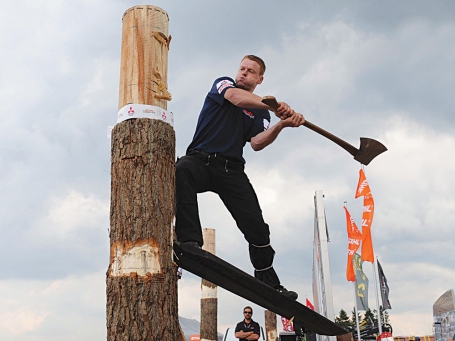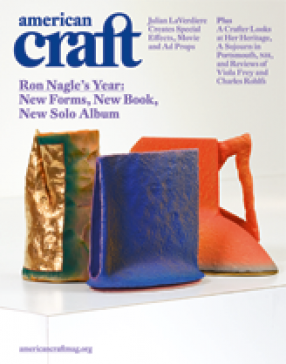Intellectually speaking, there isn’t much difference between a Pilchuck glassblowing demo and a televised lumberjacking competition.
“Power, precision, speed, accuracy.” The motto of the American Craft Council? No, it’s the slogan of Stihl Timbersports, a televised competition in which contestants go head-to-head cutting through logs with an ax (this takes about twelve seconds), a two-person bucksaw (thirteen seconds) or a chainsaw (seven). The winners tend to be macho men from countries noted for their forestry, such as Australia, New Zealand, Canada, Austria and Denmark. The atmosphere of the show, however, is strictly World Wide Wrestling Federation. The audience hoots enthusiastically, and rock music blares on the soundtrack. When I caught the program on German television, it was immediately followed by the World's Strongest Man finals.

Timbersports is an example of a phenomenon I have been noticing a lot recently: manual skill presented in as pure and extreme a form as possible. In fine art, we have Tara Donovan, who makes sculptures like a three-foot-high cube of toothpicks, held together with nothing but friction, or Dave Cole, who has knitted giant teddy bears from strips of lead. Until recently you could watch the television show Craft Corner Deathmatch, on which contestants were challenged to glue-gun items into existence in ten minutes or less, before being judged by the Craft Lady of Steel. Pushed to unreasonable lengths, skill is exerting an unprecedented hold on the public imagination. Why?
Timbersports may have something to tell us about that. I would argue that it is actually a show about craft, but not in the artistic sense. This is what a German would call handwerk - which implies a sense of skill but not necessarily an aesthetic sensibility - as opposed to kunsthandwerk, or “artistic craft.” (The same distinction exists in other languages. In Japanese, for example, a sharp distinction has sometimes been made between dentô kôgei and kôgei bijutsu, “traditional craft” and “art craft,” respectively.) Skill in this arena is judged objectively, in milliseconds. When a crowd goes wild for two large men in tight T-shirts wielding axes, they aren't looking for “art craft.” They are after something more primal, more certain, than that.
In studio craft circles, we are used to dismissing such displays of raw skill. If workmanship doesn't lead to something conceptually convincing or stylistically arresting, it finds no place in craft museums, magazines and history books. There are at least two problems with this attitude. First, the craft movement has long depended on the instantaneous appeal of handwerk, in the form of craft performances at expositions, fairs, conferences and the like. Intellectually speaking, there isn't much difference between a Pilchuck glassblowing demo and a televised lumberjacking competition. But that doesn't mean that either is inconsequential. Feats of pure skill, considered independently from artistic achievement, are a powerful force in craft culture.
Second, if craft is a process, it makes little sense to judge it by its results alone. An important new documentary by Faythe Levine, Handmade Nation, attests to this. The young crafters captured by her camera are not necessarily great artists or designers, but they are impassioned: anti-globalist, environmentalist, feminist, queer, “slow,” subcultural. Cutting down forests certainly isn't on their agenda. The men of Timbersports would have to agree with the central tenet of diy, though: it’s the doing that counts, not the product.
So this is one way that new audiences are connecting with craft: as a stripped-down, nonartistic, but nonetheless satisfying experience. This is probably because it feels “real.” Of course, there’s no actual necessity at work here. No one needs to chop a tree down by hand anymore, nor do we need an endless choice of bespoke mittens. At a moment when authenticity is a precious commodity, though, this is how people seem to want their craft. Mediated, yes. But definitely uncut.
Glenn Adamson is head of graduate studies at the Victoria and Albert Museum, London, and co-editor of the Journal of Modern Craft.




